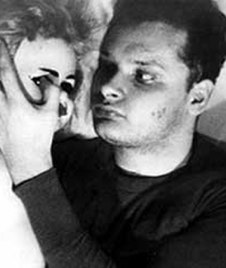On DVD: Catching Up With the Kuchars
 Beginning with an apt, hand-drawn homage to the credits of Tim Burton's Ed Wood, Jennifer Kroot's documentary It Came from Kuchar launches you into a movie-movie realm you might not have had a chance to experience before: the eccentric, dimestore film universe of the Brothers Kuchar.
Beginning with an apt, hand-drawn homage to the credits of Tim Burton's Ed Wood, Jennifer Kroot's documentary It Came from Kuchar launches you into a movie-movie realm you might not have had a chance to experience before: the eccentric, dimestore film universe of the Brothers Kuchar.
George and Mike Kuchar were just two film-crazy and intensely weird Bronx twins who went to the movies almost every day growing up and were given a 8mm camera for their 12th birthday. After that, American "underground cinema," as it was beginning to be known then in the shape of Kenneth Anger, Andy Warhol and Stan Brakhage, became a playground for the brothers. They made torrid, ludicrous, never-less-than-unconvincing horror films and melodramas in their mother's apartment and on the city's rooftops, using their neighbors and friends. Seeing a Kuchar film is like getting an intravenous eight-ball of movieness, but without the screenwriting, polish and taste.
Kroot's portrait of the brothers, starting with one of the outlandish filmmaking classes George has been teaching in San Francisco for decades, is a great place to start, contextualizing the bros' movies with testimonials from John Waters, Guy Maddin, Atom Egoyan, longtime pal Buck Henry, comic artist Bill Griffith, and many others. You need context, because Kuchar films are both unlike "regular" movies in every way and very much the essence of pop cinema distilled down to its vapors. Logical story, believable sets, honest acting -- forget it. From their first big "success" I Was a Teenage Rumpot (1960), the Kuchars' unspoken contention was that what we love about movies more than cohesion and structure is sensational moments -- raw emotional explosions. You can test the theory like this: Think of a movie you saw 10 or maybe 20 years ago. What do you remember most about it? The nuances of plot construction, or a morsel of action, an expression or movement or mood?
Kuchars take those little bits, which may be all they see, and hypercharge them, filling their cheapjack matinee scenarios with chintz, masturbatory comedy, overacting, clownish makeup, self-consciously ridiculous action, and an overall sensibility to which no amount of lurid nonsense is too much. When Waters and co. claim that the Kuchars' films are "just as good" as ordinary Hollywood movies, they're missing the point. (They may well mean it, since every campy, punky, "transgressive" film made since 1965 has ridden on the Kuchars' coattails.) A big-budget genre film is to a Kuchar film what a giant jellyfish is to a few drops of its purified poison.
 Still, the Kuchars have been "avant-garde" only insofar as their work is otherwise uncategorizable. It's semi-clear from Kroot's film that both brothers are still very weird men, mentally off-kilter and possibly Asperger's-y, and may have ended up janitors if they hadn't been ruled by the urge to create. (Both are accomplished pop-art painters.)
Still, the Kuchars have been "avant-garde" only insofar as their work is otherwise uncategorizable. It's semi-clear from Kroot's film that both brothers are still very weird men, mentally off-kilter and possibly Asperger's-y, and may have ended up janitors if they hadn't been ruled by the urge to create. (Both are accomplished pop-art painters.)
Kroot's film is a companion to Mary Jordan's doc Jack Smith and the Destruction of Atlantis, and like Smith's self-created artificial world, the Kuchars could be said to have persevered in crafting a new world out of movie reflexes, to replace the ordinary life that disinterested them so. The gambit seems to have worked, all told. But whether you come away wanting to see, in their entirety, Sins of the Fleshapoids (1965), The Craven Sluck (1967), The Devil's Cleavage (1975, and Maddin's fave) and so on, or whether Kroot's film by itself is all the Kuchar you can handle, the movie world will seem a far larger and less predictable place.

Comments
The Berlin Biennale is showing a series of George Kuchar videos at one of its venues in the city. It's delightfully curated, and shown in an abandoned parking garage in the Mehringdamm district. Definitely recommended if you're in the city.
LOVE the Kuchar Brothers' films. I'll pick this up for sure.
Fun tip: several Kuchar films can be seen at Ubuweb for free.